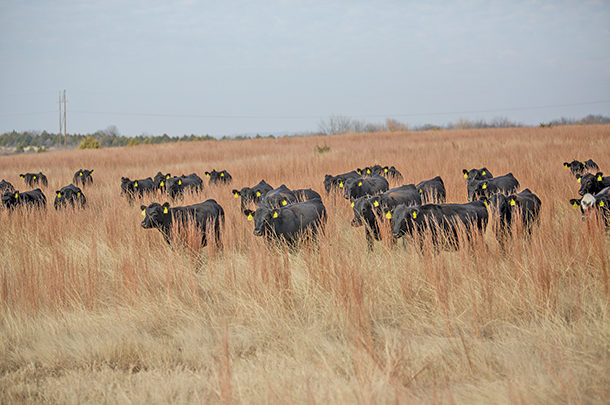For the vast majority of cow-calf producers, this time of year is scored with the chorus of freshly weaned calves. The majority of our focus right now is directed toward weaning strategies, alleviating stress, vaccination protocols, nutrient management and marketing of the 2020 calf crop – and rightfully so. That pen of calves signifies the return on both your investment and your efforts during the past year. But now is also the time to keep in mind next year’s calf crop – the calves in utero that are put out to dormant pasture with your “dry cows” for the winter.
Consider this as your annual reminder that your dry, bred cow is the most valuable asset in your herd right now. Not only is she carrying next year’s paycheck, but you still have many opportunities to influence that calf’s potential through management. One of those opportunities is now while the cow is still programming that calf’s metabolic, reproductive and immune systems.
Spring-calving cows weaned in September and October experience their lowest nutrient requirements of the year around November and December. For example, a 1,200-pound cow nine months post-calving will require about 7% crude protein (CP) and 47% total digestible nutrients (TDN) on a dry matter basis. However, if you’re grazing either dormant bermudagrass or native pasture, quality can be as low as 4% to 6% CP, even as early as October.
TDN can usually be met adequately up until about two months pre-calving, meaning that the late fall and early winter months of feeding your dry cows should be focused on supplying protein. Depending on your forage base, that may need to start even now.
I start getting calls about feeding dry cows on dormant pastures far too late in the year; the bulk of them usually come in late November and into December. It’s easy to overestimate what your pastures are supplying when they aren’t completely dried up yet, before you start to see condition drop in your cows. But by the time you do start seeing decline in a cow’s condition, she’s already gotten behind and it’s difficult to catch up. Be proactive and consider how you’re going to manage her beginning right now. Here are a few things that help you get on top of her requirements and stay there:
Manure scoring
It is good practice to keep body condition scores (BCS) on your cattle (cows, bulls, heifers), but BCS is a retrospective metric. It can tell you about where a cow was and what was happening a couple or few months ago, but very little about the relationship between her nutrient needs and her diet right now. Manure scoring is a real-time measurement that tells you about her nutrition that very day. Keeping an eye on the back end of your cattle can tell you when to step up your supplementation. Most agriculture extension offices have fact sheets available to give you a benchmark for scoring. This can help you ease into the feeding season. Start early and low, and build up pounds or nutrient density as her requirements amp up closer to calving.
Forage sampling
There is not a producer, consultant or nutritionist who can just look out at a pasture and know the quality of the total forage availability and the quality of the diet cattle will select. A feed supplement is merely to meet the deficit when you subtract the nutrients available from the diet (forage) from a cow’s nutrient requirements. It helps you, your nutritionist and your pocketbook know what your cattle have to choose from. Sample your forage selectively. To try and get a representative sample for testing, take the leaves and avoid reproductive stems as well as the plants you know they won’t eat. This gives you a baseline to begin supplementing, and manure scoring can help you keep on top of things as requirements increase.
Limiting nutrient
Always buy a supplement and feed according to the limiting nutrient. As a general rule of thumb, and as aforementioned, the limiting nutrient for a spring-calving cow will be protein until about two months before calving (so generally, the first of the year). I tell producers to focus on protein until Christmas.
The bulk of fetal growth occurs during the last two months of gestation, and a lot of energy is rolled into that growth. A cow’s requirements reflect that, and her need for TDN increases rapidly during this time. It’s easy to get too focused on protein and forget about her need for energy. Protein is expensive, and no amount can compensate for an energy deficit. Be aware of her changing needs and plan ahead so you can be flexible.
Adjust your supplementation to meet her requirements as they morph through the winter. This takes a little more foresight and awareness, but you can save by not overfeeding expensive nutrients. On that note, always price your supplements by the pound of limiting nutrient. This is true for all supplement types but especially for “convenience” supplements like range cubes or tubs. Less expensive per ton does not always equate to less expensive to feed.
There’s a lot going on right now. Marketing cattle in a COVID-19 world has probably induced some stress – as if managing those weaned calves isn’t usually hectic enough. But be sure to allot some time and focus toward that dry cow and her precious cargo. Staying ahead of the game with her condition and requirements can keep you ahead of the game financially. This foresight will also give next year’s calf the solid start it needs to perform well and help make sure the cow is set up to have another successful breeding season in the spring.








